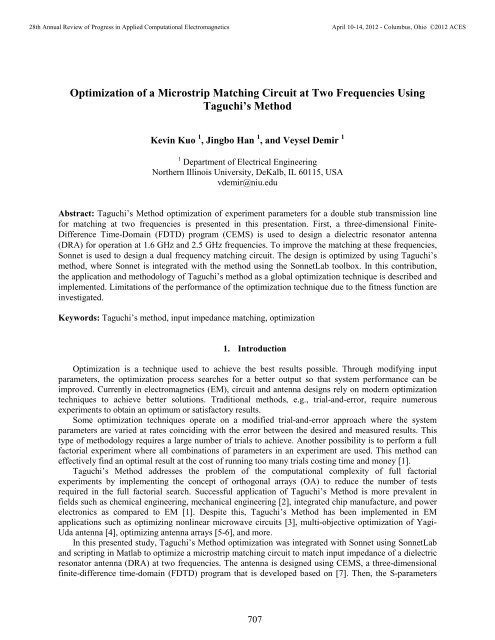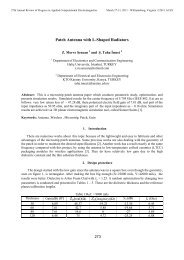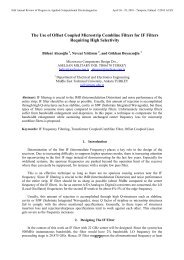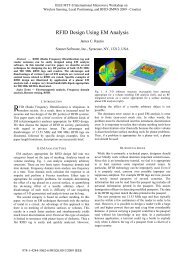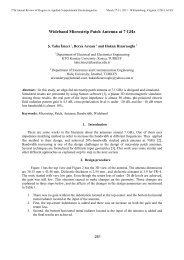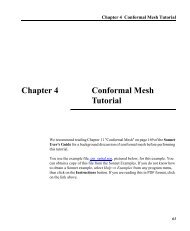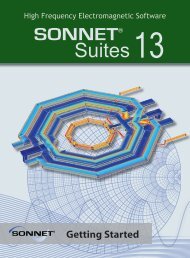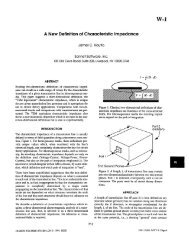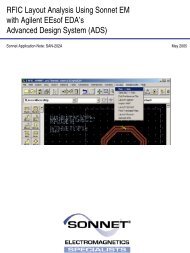Optimization of a Microstrip Matching Circuit at ... - Sonnet Software
Optimization of a Microstrip Matching Circuit at ... - Sonnet Software
Optimization of a Microstrip Matching Circuit at ... - Sonnet Software
Create successful ePaper yourself
Turn your PDF publications into a flip-book with our unique Google optimized e-Paper software.
28th Annual Review <strong>of</strong> Progress in Applied Comput<strong>at</strong>ional ElectromagneticsApril 10-14, 2012 - Columbus, Ohio ©2012 ACES<strong>Optimiz<strong>at</strong>ion</strong> <strong>of</strong> a <strong>Microstrip</strong> <strong>M<strong>at</strong>ching</strong> <strong>Circuit</strong> <strong>at</strong> Two Frequencies UsingTaguchi’s MethodKevin Kuo 1 , Jingbo Han 1 , and Veysel Demir 11 Department <strong>of</strong> Electrical EngineeringNorthern Illinois University, DeKalb, IL 60115, USAvdemir@niu.eduAbstract: Taguchi’s Method optimiz<strong>at</strong>ion <strong>of</strong> experiment parameters for a double stub transmission linefor m<strong>at</strong>ching <strong>at</strong> two frequencies is presented in this present<strong>at</strong>ion. First, a three-dimensional Finite-Difference Time-Domain (FDTD) program (CEMS) is used to design a dielectric reson<strong>at</strong>or antenna(DRA) for oper<strong>at</strong>ion <strong>at</strong> 1.6 GHz and 2.5 GHz frequencies. To improve the m<strong>at</strong>ching <strong>at</strong> these frequencies,<strong>Sonnet</strong> is used to design a dual frequency m<strong>at</strong>ching circuit. The design is optimized by using Taguchi’smethod, where <strong>Sonnet</strong> is integr<strong>at</strong>ed with the method using the <strong>Sonnet</strong>Lab toolbox. In this contribution,the applic<strong>at</strong>ion and methodology <strong>of</strong> Taguchi’s method as a global optimiz<strong>at</strong>ion technique is described andimplemented. Limit<strong>at</strong>ions <strong>of</strong> the performance <strong>of</strong> the optimiz<strong>at</strong>ion technique due to the fitness function areinvestig<strong>at</strong>ed.Keywords: Taguchi’s method, input impedance m<strong>at</strong>ching, optimiz<strong>at</strong>ion1. Introduction<strong>Optimiz<strong>at</strong>ion</strong> is a technique used to achieve the best results possible. Through modifying inputparameters, the optimiz<strong>at</strong>ion process searches for a better output so th<strong>at</strong> system performance can beimproved. Currently in electromagnetics (EM), circuit and antenna designs rely on modern optimiz<strong>at</strong>iontechniques to achieve better solutions. Traditional methods, e.g., trial-and-error, require numerousexperiments to obtain an optimum or s<strong>at</strong>isfactory results.Some optimiz<strong>at</strong>ion techniques oper<strong>at</strong>e on a modified trial-and-error approach where the systemparameters are varied <strong>at</strong> r<strong>at</strong>es coinciding with the error between the desired and measured results. Thistype <strong>of</strong> methodology requires a large number <strong>of</strong> trials to achieve. Another possibility is to perform a fullfactorial experiment where all combin<strong>at</strong>ions <strong>of</strong> parameters in an experiment are used. This method caneffectively find an optimal result <strong>at</strong> the cost <strong>of</strong> running too many trials costing time and money [1].Taguchi’s Method addresses the problem <strong>of</strong> the comput<strong>at</strong>ional complexity <strong>of</strong> full factorialexperiments by implementing the concept <strong>of</strong> orthogonal arrays (OA) to reduce the number <strong>of</strong> testsrequired in the full factorial search. Successful applic<strong>at</strong>ion <strong>of</strong> Taguchi’s Method is more prevalent infields such as chemical engineering, mechanical engineering [2], integr<strong>at</strong>ed chip manufacture, and powerelectronics as compared to EM [1]. Despite this, Taguchi’s Method has been implemented in EMapplic<strong>at</strong>ions such as optimizing nonlinear microwave circuits [3], multi-objective optimiz<strong>at</strong>ion <strong>of</strong> Yagi-Uda antenna [4], optimizing antenna arrays [5-6], and more.In this presented study, Taguchi’s Method optimiz<strong>at</strong>ion was integr<strong>at</strong>ed with <strong>Sonnet</strong> using <strong>Sonnet</strong>Laband scripting in M<strong>at</strong>lab to optimize a microstrip m<strong>at</strong>ching circuit to m<strong>at</strong>ch input impedance <strong>of</strong> a dielectricreson<strong>at</strong>or antenna (DRA) <strong>at</strong> two frequencies. The antenna is designed using CEMS, a three-dimensionalfinite-difference time-domain (FDTD) program th<strong>at</strong> is developed based on [7]. Then, the S-parameters707
28th Annual Review <strong>of</strong> Progress in Applied Comput<strong>at</strong>ional ElectromagneticsApril 10-14, 2012 - Columbus, Ohio ©2012 ACESmethod, where the script changed the design parameters and ran <strong>Sonnet</strong> simul<strong>at</strong>ions <strong>of</strong> the m<strong>at</strong>chingcircuit using <strong>Sonnet</strong>Lab.2. Taguchi’s MethodThe development <strong>of</strong> Taguchi’s method is based upon the efficiency <strong>of</strong> orthogonal arrays (OAs) in thedesign <strong>of</strong> experiments. OAs provide an efficient method to control design parameters such th<strong>at</strong> optimalresults can be obtained with minimal runs [1]. A full factorial experiment <strong>of</strong> 4 tunable parameters, each <strong>of</strong>which is separ<strong>at</strong>ed into 3 discrete levels, is prepared. The levels correspond to different numerical valuesrel<strong>at</strong>ive to the minimum and maximum range <strong>of</strong> the parameter in question. For example if theoptimiz<strong>at</strong>ion range <strong>of</strong> parameter 1 is [0, 8], the levels (1, 2, 3) for parameter 1 are (2, 4, 6). Theexhaustive testing <strong>of</strong> the experiment would require 3 4 = 81 trials.The OA( N, k, s,t ) not<strong>at</strong>ion defines an orthogonal array where S is a set <strong>of</strong> s levels and a m<strong>at</strong>rix A <strong>of</strong>N rows and k columns and entries from S. In every N× t subarray <strong>of</strong> A, each t-tuple based on S appearsexactly the same times as a row [1]. In this case, an OA ( 9,4,3,2), as can be seen in Table 1, could beused to reduce the number <strong>of</strong> trials from 81 to 9.There are three fundamental properties <strong>of</strong> OAs th<strong>at</strong> highlight the utility <strong>of</strong> Taguchi’s Method. Thefirst is th<strong>at</strong> while the full factorial str<strong>at</strong>egy requires 81 trials, the OA ( 9,4,3,2)needs only 9 trials.St<strong>at</strong>istical results demonstr<strong>at</strong>e th<strong>at</strong> the optimum outcome from the OA is close to th<strong>at</strong> obtained from thefull factorial approach. Second, all possible combin<strong>at</strong>ions <strong>of</strong> up to t parameters occur equally, whichensures a balanced and fair comparison <strong>of</strong> levels for any parameter and any interactions <strong>of</strong> parameters. Inshort, the OA is optimized as the results <strong>of</strong> the trials are uncorrel<strong>at</strong>ed. Thirdly, any N× k′ subarray <strong>of</strong> anexisting OA( N, k, s,t ) is still an OA with not<strong>at</strong>ion OA( N, k′ , s,t′ ) . This makes the selection <strong>of</strong> an OAfrom an existing OA d<strong>at</strong>abase easy even with experiments <strong>of</strong> varying number <strong>of</strong> parameters andrequirements.Table 1: OA ( 9,4,3,2)Trial Parameter 1LevelParameter 2LevelParameter 3LevelParameter 4Level1 1 1 1 12 1 2 2 23 1 3 3 34 2 1 2 35 2 2 3 16 2 3 1 27 3 1 3 28 3 2 1 39 3 3 2 1The optimiz<strong>at</strong>ion procedure for Taguchi’s Method starts with the selection <strong>of</strong> a proper OA and thedesign <strong>of</strong> a suitable fitness function. The OA selection mainly depends upon the number <strong>of</strong> optimiz<strong>at</strong>ionparameters, N, while compens<strong>at</strong>ion for the non-linear n<strong>at</strong>ure <strong>of</strong> the system can be tuned through s [1].For the design <strong>of</strong> the double stub transmission line, there are 4 parameters to be chosen: the length(L1) and distance (D1) <strong>of</strong> the first stub from the load impedance (antenna) and then the length (L2) anddistance (D2) <strong>of</strong> the second stub from the first stub. The initial optimiz<strong>at</strong>ion ranges for L1, D1, L2, D2were L1=[5, 30], D1 = [0, 40], L2 = [5, 40], and D2 = [0, 66.8].The fitness function is designed with respect to the optimiz<strong>at</strong>ion goal. Fitness is a measurement <strong>of</strong> thedifference between the optimiz<strong>at</strong>ion goal (0 value) and the obtained value from the current inputs. Thesmaller the fitness value, the better the m<strong>at</strong>ch between the obtained value and the desired value. With the709
28th Annual Review <strong>of</strong> Progress in Applied Comput<strong>at</strong>ional ElectromagneticsApril 10-14, 2012 - Columbus, Ohio ©2012 ACESdesign goal <strong>of</strong> minimizing return loss the ensuing fitness function is22Fitness = [ S11 (1.6GHz)]+ [ S11(2.5GHz)], (1)where S ( ) 11f denotes the input port reflection coefficient <strong>at</strong> frequency f. Ideally we would like to achieve<strong>at</strong> least -10 dB m<strong>at</strong>ching <strong>at</strong> both oper<strong>at</strong>ional frequencies but the fitness function is designed to converge towhere the most combined power is transmitted.After designing the fitness function, input parameters with which the experiments are conducted arechosen. When the OA is used, the corresponding numerical values for the three levels <strong>of</strong> each inputparameter need to be determined. In the first iter<strong>at</strong>ion, the value for level 2 is selected <strong>at</strong> the center <strong>of</strong> theoptimiz<strong>at</strong>ion range. The values <strong>of</strong> levels 1 and 3 are calcul<strong>at</strong>ed by modifying the value <strong>of</strong> level 2 with thevariable called level difference LD. The level difference <strong>of</strong> the first iter<strong>at</strong>ion (LD1) is determined bymax−minLD1=# levels − 1, (2)where min and max are the lower and upper bound <strong>of</strong> the optimiz<strong>at</strong>ion ranges, respectively.After determining the input parameters, the fitness function for each experiment can be calcul<strong>at</strong>ed.Fitness values are converted into signal-to-noise (S/N) r<strong>at</strong>io (η) in Taguchi’s method usingη = − 20log( Fitness), (3)where Fitness is the fitness function (1). These results are used to build a response table for the firstiter<strong>at</strong>ion by averaging the S/N r<strong>at</strong>io for each parameter n and each level m usingsη( mn , ) = ∑ ηi. (4)N i, OA(, i n)= mFinding the largest S/N r<strong>at</strong>io in each column can identify the optimal level for th<strong>at</strong> parameter. Once theoptimum levels are identified, a confirm<strong>at</strong>ion experiment is performed using the combin<strong>at</strong>ion <strong>of</strong> theoptimal levels identified in the response table. The fitness value obtained from the optimal combin<strong>at</strong>ion isregarded as the fitness value <strong>of</strong> the current iter<strong>at</strong>ion [1].If the results from the current iter<strong>at</strong>ion fail to meet termin<strong>at</strong>ion criteria, the process is repe<strong>at</strong>ed in thenext iter<strong>at</strong>ion with a reduced optimiz<strong>at</strong>ion range for a converged result. The LD <strong>of</strong> the current iter<strong>at</strong>ionLD i is modified by a reduced r<strong>at</strong>e (rr) to obtain the LD <strong>of</strong> the next iter<strong>at</strong>ion LD i +1. Both linear andGaussian reduced r<strong>at</strong>es were used in the simul<strong>at</strong>ion. The linear reduced level difference can be describedbyLD = i 1rr × +LD , (5)iwhere rr is a constant value in the range [.5,1). The larger the value <strong>of</strong> rr, the slower the convergence r<strong>at</strong>e<strong>of</strong> the problem. The Gaussian reduced level difference can be described byLD = i 1rr()i × +LD , (6)iwhere( iT) rr()i = e − 2, (7)and T is the dur<strong>at</strong>ion width <strong>of</strong> the Gaussian function. The Gaussian function reduces the LD slowlyduring the first several iter<strong>at</strong>ions to <strong>of</strong>fer the optimiz<strong>at</strong>ion process more degrees <strong>of</strong> freedom whiledecreasing the LD <strong>at</strong> a faster r<strong>at</strong>e to speed up the convergence. The procedure is repe<strong>at</strong>ed until theexperimental results for all 9 experiments converge to the same result.3. ResultsThe simul<strong>at</strong>ion results yielded by <strong>Sonnet</strong> using Taguchi’s Method can be seen in Table 2. All <strong>of</strong> thesimul<strong>at</strong>ion results met our desired performance <strong>of</strong> <strong>at</strong> least -10 dB m<strong>at</strong>ching <strong>at</strong> each frequency. Asexpected, as the value <strong>of</strong> rr increases, so does the m<strong>at</strong>ching <strong>at</strong> the two oper<strong>at</strong>ional frequencies. Thiscomes <strong>at</strong> a cost <strong>of</strong> an increased number <strong>of</strong> trials required for final convergence. This is most clearly seenin the rr = 0.9 case where 570 trials is needed as compared to the 140 and 150 trials when rr is 0.5 and0.7, respectively. However, if return loss needs to be minimized as much as possible, the large number <strong>of</strong>710


